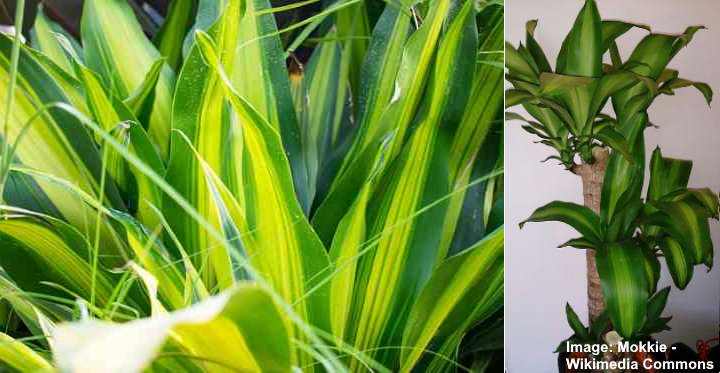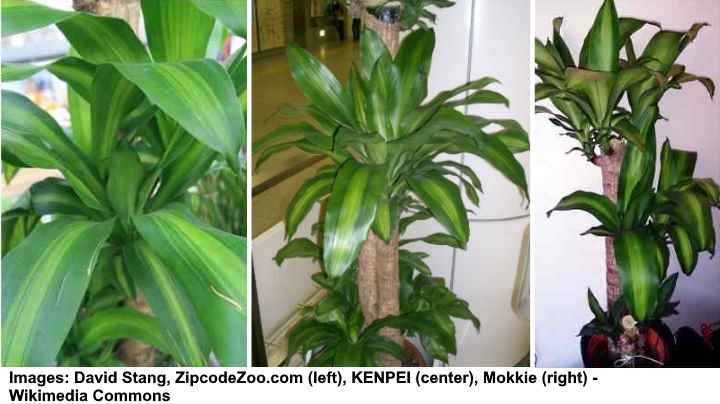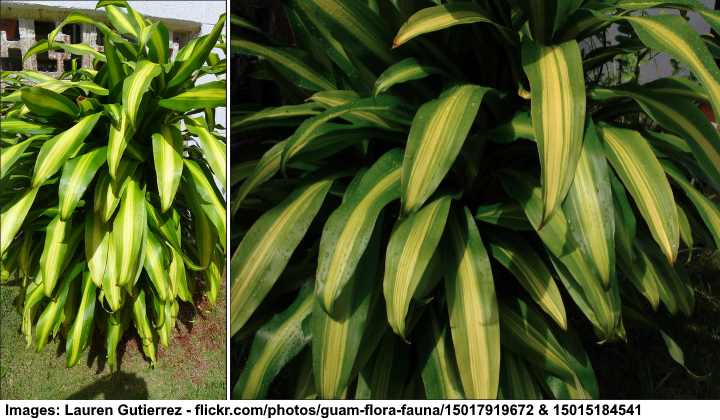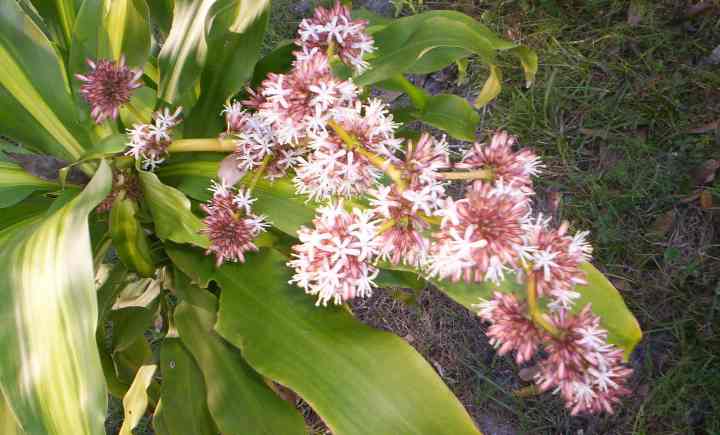Mass Cane (Dracaena Massangeana): Care and Plant Growing Guide

The mass cane plant, also known as corn plant or Dracaena massangeana, is a popular upright evergreen houseplant in the genus Dracaena. This tropical tree-like flowering plant is a cultivar of Dracaena fragrans species, hence its full scientific name is Dracaena fragrans ‘massangeana’.
The mass cane plant has a leafy crown of long, sword-shaped, arching leaves. Its shiny green leaves have golden-yellow stripes running down the center.
How to Care For Mass Cane Plant – Overview
To care for mass cane plant (Dracaena massangeana) grow it in well-draining potting soil and high humidity. Water the plant when the soil is partially dry. Place the mass cane in a bright room with indirect sunlight. The ideal temperature range is 60°C to 75°F (15°C – 24°C). Fertilize monthly in the growing season.
Mass Cane Plant Information
Mass cane plants are native to Africa, where they can grow to over 50 ft. (15 m) tall. Growing indoors, a potted mass cane tree can grow to between 4 and 6 ft. (1.2 – 1.8 m) tall.
The attractive feature of mass cane plants is their glossy green foliage gracing the top of thick woody stems. Their arching leaves grow up to 3 ft. (1 m) long and up to 4” (12 cm) wide.
Mass cane plants are low-maintenance houseplants that make them popular in homes and offices. Although they thrive in bright light, they also grow well in low-light conditions. With minimal care—even some neglect—Dracaena massangeana canes will grow almost anywhere indoors.
This article is a comprehensive guide to caring for mass cane plants. You will also learn how to resolve any problems with growing Dracaena corn plants indoors.
How to Care for Mass Cane Plant (Dracaena massangeana)
The most important care tips to caring for mass cane plants at home are to give them enough light, water when the top layer of soil is dry, and mist the leaves regularly. To help your cane tree thrive, it’s also crucial to get the soil density right so it has excellent drainage.
Let’s look in more detail at how to make sure your plant thrives in your home or office.
Mass Cane Light Requirements

Mass cane plant prefers moderate indirect light but can also tolerate low light which can slow its growth
Dracaena massangeana needs moderate bright light, protected from direct sunlight. Light helps the indoor tree-like plant grow well. Mass cane plants will also grow in shaded areas or rooms with little natural sunlight. The best place for a mass cane pot is near an east-facing window.
You should protect a mass cane plant from strong, direct sunlight. The light and heat from the sun can discolor the beautiful shiny yellow-green foliage. Also, the sun’s rays beating on the plant will cause moisture to evaporate, and the soil will dry out too quickly.
Because mass cane houseplants are tolerant of low light, you can put them in almost any room of the house. You may notice that their growth is slower in low light, and the vibrancy of their leaves can fade. But mass cane plants are excellent bedroom plants, and their love of humidity makes them ideal for growing in bathrooms.
Best Soil for Dracaena Massangeana
Mass cane plants thrive in loose potting soil with excellent drainage. A general potting mix for houseplants is ideal for the corn plant as long as water flows freely. Cane plants don’t like sitting in water so mix in some peat moss to the potting soil. This adds organic matter and helps improve drainage.
When growing mass canes in pots, make sure there are plenty of drainage holes in the bottom. Excess water needs to drain quickly to prevent root rot. If you notice that the soil is too dense, mix in some perlite to let water drain better from the soil. Or, you may need to check that the small indoor tree hasn’t become root bound in the pot.
How to Water Mass Cane Plants

Water cane plant when the top soil has dried out rather than on a set schedule
Water a mass cane plant as often as the top layer of soil is dry. The frequency of watering depends on the amount of light it gets. In bright light, you may need to water it every week. In shaded areas or low light, water less frequently.
The general rule when it comes to watering is to let the soil moisture levels be your guide. Before watering, poke your finger 1” to 2” (2.5 – 5 cm) into the soil. If the medium is dry, it’s time to water the cane plant. If there’s moisture, wait until it dries more.
The proper plant watering schedule is crucial to the health of your Dracaena massangeana. If you hydrate it too much, leaves will start to yellow, and the tips become brown. Not enough water—your mass cane may show similar symptoms. So, let the soil be your guide and only water when the potting mix is partially dry.
Another watering tip for caring for your mass cane plant is to use distilled, filtered, or rain water. Tap water contains chemicals that can build up in the soil. But if you have to use tap water, let it sit out for 24 hours so the chlorine and other chemicals can evaporate. These chemicals may cause brown tips, weak growth, and, eventually, death.
Temperature Requirements for Mass Cane Indoor Care
The ideal temperature range for Dracaena plants is 60°F to 75°F (15°C – 24°C). So, average room temperatures are ideal for healthy mass cane plant growth. During the night, corn plants can withstand a drop of 50°F (10°C). It is essential to protect mass canes from sudden changes in temperature.
In summer, care for mass cane plants by moving them away from windows where the sun shines directly on them. Also, make sure the Dracaena pot isn’t sitting in cold drafts from open windows or air-conditioning. During winter, protect the houseplants from hot radiators.
It’s vital to spot the signs when a mass cane plant is suffering in extreme temperatures. Curling leaves or drooping growth are signs you need to find a better location for the plant pot.
You can grow mass cane plants outside as long as the temperature is above 60°F (15°C). Choose a spot in your garden, patio, or deck in dappled light. When the nighttime temperatures drop below 50°F (10°C), it’s time to take your cane tree back indoors.
Mass Cane Plant Humidity Requirements
Dracaena plants need a humidity level of between 40 and 50 percent. Mass cane plants appreciate regular misting that creates extra humidity. You can also wipe leaves with a damp cloth for hydration or grow corn plants close to other house plants to create a humid environment.
Mass cane plants are native to tropical environments where they thrive in high humidity. Although they prefer growing in humid conditions, they will also grow well in average household humidity. If you notice that the plant’s leaves are drooping, you can spray a fine mist on the foliage with some distilled water to revive them.
Mass Cane (Dracaena Massangeana) Flowers

Dracaena fragrans ‘Massangeana’ rarely flowers when grown as a houseplant
Mass cane plants are flowering tropical tree-like plants. In their native habitat, they produce clusters of pinkish-white flowers that bloom loosely on arching stems. The strongly-scented flowers open in the evening time and look like delicate white spiky blossoms. Mass canes can flower in late fall and late spring.
Unfortunately, it’s rare—if ever—that Dracaena plants flower indoors. Some houseplant owners say that only after years of indoor cultivation, and in the right conditions could a mass cane plant produce flowers. However, the lush, glossy yellow and green foliage makes up for any lack of flowers.
Mass Cane Growth Rate
Growing indoors, mass cane plants are slow growers. It can take many years for them to reach their maximum height of 6 ft. (1.8 m). However, their slow growth means they are ideal for growing indoors. The bushy indoor shrubs will fill a corner of your room without becoming too big for its space.
Fertilizer Needs for Healthy Mass Cane Plant Growth
Fertilize mass cane plants once a month during the growing season and don’t feed during the fall or winter. Use a general balanced household fertilizer and dilute to half of the manufacturer’s instructions. The slow growth of Dracaena massangeana means that they have modest feeding requirements.
Because Dracaena plants aren’t heavy feeders, they can succumb to mineral burn. This happens when excess fertilizer salts build up in the soil. Even if you occasionally apply fertilizers, the plants can show signs of root burn. To promote healthy growth, it’s a good idea to flush the soil every once in a while.
To remove excess mineral salts from houseplant soil, run water through the soil for two to three minutes. Allow all the excess water to drain before putting the plant back in its favorite location.
If you grow mass cane plants in organically-rich soil, it may not be necessary to apply fertilizer.
It’s also important to remember that too much fertilizer can be a reason why mass cane plants die. So, if you’re unsure about fertilization, apply a diluted fertilizer at half-strength in spring and again in late summer.
How to Propagate Mass Cane Plants

You can easily propagate cane plants by stem cuttings
The best time for Dracaena plant propagation is in spring or summer when growth is the most vigorous. Propagating a mass cane plant is straightforward by the stem cutting method. Place the stem directly into an appropriate potting soil mix to grow a new tree.
To propagate a mass cane plant: Cut a healthy stem that is at least 3” (7.5 cm) long that has several little buds on it. Make the cut just under the horizontal line. Place the cutting 1” (2.5 cm) into the soil in a new pot. Water thoroughly and place in a bright spot.
Pruning Mass Cane Plant Leaves
Mass cane plants generally don’t need pruning. The leafy tropical plant has natural bushy growth, and pruning doesn’t speed up growth. The only time you need to prune Dracaena plants is to remove dead, yellowing leaves or to control its height.
To prune your mass cane plant if it’s getting too tall, cut the stems to the required heights. New buds will start to grow at the end of the stem and develop into a new bushy crown of shiny green foliage.
Repotting a Mass Cane Plant
Dracaena cane plants may require repotting every two to three years. Transferring a plant into a larger container with fresh potting soil encourages growth and good health. While repotting, you can check for dead or diseased roots and remove them. Also, a larger pot allows more rooms for roots to grow.
To repot your indoor cane tree, remove the plant and root ball from its pot. Shake off all dirt from around the roots and run water over the roots to rinse them. Gently try to untangle roots if necessary. Prune off any brown, mushy roots. Fill a new, sterile pot, half-full with the appropriate potting soil. Put your mass cane plant in the pot and fill the remaining space with soil. Thoroughly water.
Pests Affecting Indoor Mass Cane Plants
Common pests that can affect mass cane plants are spider mites, mealybugs, scale insects, and thrips. If these pesky bugs attack your plant, you will see signs of infestation under leaves and on stems. Getting rid of mass cane pests is by applying a neem oil solution.
How can you spot the signs of common houseplant pests on Dracaena? Here are a few pests affecting indoor mass cane plants:
- Spider mites—These tiny mites are difficult to spot. You may notice spider mite activity by webbing under the leaves and between stems of mass cane plants. Get rid of spider mites by spraying a soap solution on the leaves and wiping with a damp cloth.
- Mealybugs—These nasty bugs are a type of scale insect that leave a cottony-wool like substance on cane plant leaves and stems. Find out in this article how to get rid of mealybugs on houseplants.
- Scale—These sap-sucking insects are hard to spot because they look like brown growths on stems. However, they feed on the mass cane plant’s sap and weaken it. Learn how to use rubbing alcohol to get rid of scale insects.
- Thrips—These minute, slender pests can damage mass cane plant growth and transmit viruses to other houseplants. Find out how to make a homemade neem oil remedy to get rid of thrips and other bugs for good.
Diseases Affecting Indoor Mass Cane Plants
Fungal diseases can affect Dracaena corn plants. The common signs of fungal disease are leaf spots and weak growth due to root rot. The leading causes of fungal-related cane plant diseases are over-watering or letting the roots to sit in water. Allowing soil to dry partially helps prevent fungal diseases.
If you notice signs of fungal diseases, it’s essential to hold back from watering until the soil partially dries. If the soil is especially soggy, try repotting the cane plant and remove any diseased roots. Prune and destroy any cane leaves that have leaf-spots to prevent spreading the fungal disease.
Are Mass Cane Plants Toxic?
Mass cane plants (Dracaena massangeana) are poisonous to cats and dogs. According to the American Society for the Prevention of Cruelty to Animals (ASPCA), signs of pet poisoning due to species of Dracaena plants are vomiting, excessive drooling, and anorexia. (1)
FAQs About Mass Cane Plant Care
Why does mass cane plant leaves have brown tips?
Over-watering is the most common cause of brown tips appearing on mass cane plant leaves. Also, adding too much fertilizer or a buildup of mineral salts can cause tips to turn brown. However, brown tips can also be a sign of low humidity or dry soil.
To find the cause of brown leaf tips, check the soil moisture for evidence of over-watering or under-watering. Adjust your watering schedule as necessary and only water as often as the top layer of soil dries out.
Why are leaves on my mass cane plant turning yellow?
Watering issues are also to blame for Dracaena leaves turning yellow. Roots that sit in soggy soil for too long start to decay and stop nutrients from getting to the leaves. The result is droopy mass cane leaves that turn yellow and fall off.
How to save a mass cane plant that’s dying?
Waterlogged soil is the main reason for Dracaena massangeana plants dying. If necessary, repot your mass cane plant to get rid of the soggy soil and trim off dead foliage and stems. Then, look for signs of houseplant pests and treat as necessary to eliminate the bugs.
If the soil is arid, leaves are drooping, and spider mites are attacking your plant, water thoroughly, and mist the leaves to revive a dying plant. Dry soil conditions and a lack of humidity attract spider mites. Plenty of hydration could bring your plant back to life if a lack of moisture caused growth to stop.
Related articles:
